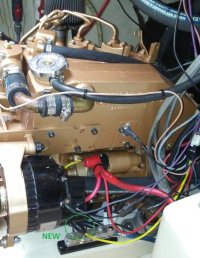Peter B
Junior Member
I'm having intermittent problems starting the engine on my '84 Ericson 30.
The engine is a Universal M-18 Diesel which, when started runs well.
The problem occurs after sailing for a while. The starter lugs and appears to not have enough power to turn over the engine.
My 3 year old batteries are at capacity, the starter/solenoid works well upon initial use (leaving the dock). Then, after sailing for a few hours, the engine (often but not always) fails to turn over.
I have personally cleaned the point-to-point connections but the problem persists.
Has anyone experienced a similar problem? Solutions anyone? THANKS!
The engine is a Universal M-18 Diesel which, when started runs well.
The problem occurs after sailing for a while. The starter lugs and appears to not have enough power to turn over the engine.
My 3 year old batteries are at capacity, the starter/solenoid works well upon initial use (leaving the dock). Then, after sailing for a few hours, the engine (often but not always) fails to turn over.
I have personally cleaned the point-to-point connections but the problem persists.
Has anyone experienced a similar problem? Solutions anyone? THANKS!


